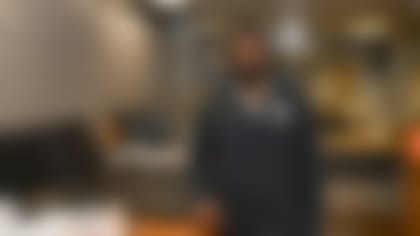On May 22, 2023, the NFL hosted a virtual press conference to announce the expansion of the Diversity in Sports Medicine Pipeline Initiative to a league-wide program. The expansion, announced in partnership with the NFL Physicians Society (NFLPS) and the Professional Football Athletic Trainers Society (PFATS), will match diverse students from 19 medical schools with NFL clubs across the league.
Speakers:
- Dr. Allen Sills, NFL Chief Medical Officer
- Dr. Timothy McAdams, President, NFL Physicians Society; Head Team Physician, San Francisco 49ers
- Reggie Scott, Past President, Professional Football Athletic Trainers; Vice President, Sports Medicine and Performance, Los Angeles Rams
- Dr. Omolayo Dada, Morehouse School of Medicine; 2022 Pipeline Initiative Participant
- Dr. Kelsey Henderson, Meharry Medical College; 2022 Pipeline Initiative Participant
Dr. Allen Sills: Good afternoon, everyone. Great to have a chance to be with you, and I'm really excited to have the chance today to speak about our NFL Diversity in Sports Medicine Pipeline Initiative Program. As some of you may know, this is a program that we launched last season as a pilot program, really in an attempt to leverage our NFL platform to make a positive impact on the diversity challenges that we face in sports medicine. I think as most of you are aware, in medicine as a whole, we feel that we don't have enough practitioners from underrepresented groups. And particularly, as we look at sports medicine – as we look at professional sports and sports at all levels – we feel like there's a real challenge and an opportunity to improve the representation of underrepresented groups. So the NFL, in partnership with the Professional Football Athletic Trainers Society and the NFL Physicians Society, last year launched a pilot program, partnering with four HBCU medical schools and bringing in a total of 14 students who spent one month really immersed in the sports medicine programs of some of our NFL clubs. The idea was to do a couple of things, to give them an immersive experience in all aspects of sports medicine, to really expose them the type of training and preparation that would be needed for that type of career, and perhaps most importantly, to provide mentorship, to provide mentors who early in their career could help shape and guide and direct people who are interested in these types of careers.
We focused on two major areas – primary care sports medicine and orthopedic sports medicine – and had a wonderful partnership and experience. Again, I can't say enough. A great thank you to the Professional Football Athletic Trainers Society, to the NFL Physicians Society and to the four HBCU medical schools who were participating last year. You'll hear some about that program, but based on that success, we're extremely excited to announce an expansion of the program this year. This year, it's going to be a league-wide initiative, and we will have students representing 19 different medical schools, students from diverse backgrounds. We'll be partnering with our clubs around the league and we'll be more than doubling the number of students who will have an opportunity to participate in this initiative this year. We think this is one of the most exciting things that we've done in NFL health and safety in a very long time. Again, we know that diversity in sports medicine is like diversity in medicine as a whole – it leads to better patient outcomes, and it is certainly something we in the NFL wants to model and take a leadership position on here.
Again, this is year two of our program. It is my hope that we'll continue to see this expand in future years. This is a multiyear commitment on our part, and our hope is to expand to other disciplines and other aspects of the sports medicine team, because we realize again that we've got a great opportunity there as well. That's just a little bit of the background, but let me turn it over and let you hear from one of our students. Dr. Kelsey Henderson is a recent – as of about two days ago – graduate of the Meharry Medical College in Nashville. I had a chance to interact with Dr. Henderson on the sidelines last year at a Titans game when the Commissioner and I were there. Dr. Henderson, let me turn it over to you just to speak a little bit about your experience and some of your thoughts around the program.
Dr. Kelsey Henderson: Thank you so much, Dr. Sills. Hello, everyone. My name is Kelsey Henderson. As Dr. Sills said, a very recent graduate of Meharry Medical College, and as one of the participants in the pilot program, I was able to do an internship experience with the Tennessee Titans last October. My initial sports medicine exposure started in undergrad. I went to the University of Tennessee and I was a kinesiology major. I like to say that I learned basic science through the lens of sports medicine. I really wanted to appreciate a holistic approach to basic sciences, and even being able to learn medicine from a pre-med standpoint in a way that was holistic and really approached the social and cultural aspects, in addition to the basic sciences of medicine. Soon after I matriculated to medical school and had exposure to the orthopedic surgery specialty through the instrumentations program, I was strongly committed to orthopedics – and specifically sports medicine as a career.
When I had the opportunity to start applying to the NFL initiative for sports medicine, I saw it as a great opportunity to see the medicine that I had fallen in love with, really, combined with my roots of kinesiology and to see how this exposure looks on a super specialized field of professional sports. Being able to work with the team with the Tennessee Titans, I immediately was immersed in the team and embraced by not only the medical staff but the nutrition staff, the trainers – they really took the opportunity to not [just] make sure my experience was confined to just the surgical aspect of the professional sports realm, and was able to see how there was a great collaborative approach to sports medicine and see all the disciplines that encompass sports medicine from an early standpoint. I was able to sit down with several members of the team to see how medicine integrated with the post-operative approach to how players went from rehabilitation to being ready for gameplay. I felt that I was really embraced and appreciated as a member of a team as a medical student learner that I was able to see how training was approached, nutrition was approached. It was a really well-rounded experience that sometimes, when you get into a specialty, you really see a very niche approach to medicine, so I was grateful to get the holistic approach that really brought me into my interest and love for medicine from an early standpoint.
As of today, I am excited to say that I matched into orthopedic surgery at the University of Arkansas. The other accolades that I got from participating in the program – I've spoken on two panels on a national and local platform for students that are interested in orthopedic surgery as a residency of choice to let them know specifically about the NFL pipeline initiative. In addition to how mentorship from the program really helped leverage my competitive nature going into the application cycle, I also believe the program helped me be very grateful to have a busy interview season for my application cycle as well. I have been inducted into the Alpha Omega Alpha medical honor society since participating in the program. It was also mentioned that my participation and, I would say, representation of Meharry Medical College did support my interest and just the visibility at my school to see that I was active as a medical student but also in the community by participating in this program.
Overall, with underrepresented minorities, even specifically at Meharry Medical College, as a predominantly primary care institution, we've seen a great increase in interest in orthopedic surgery. Now that this interest has been garnered, there has to be a concerted effort to support [this]. The expansion of the NFL pipeline program really gives us the opportunity to have concerted, formalized programs that support the equitable nature of helping the matriculation and match of underrepresented minorities in medicine get access, networking and mentorship to have early exposure, but also have guidance to successfully matriculate into the field of sports medicine and even professional sports medicine within orthopedic surgery. I've been extremely grateful. I think my picture with Dr. Sills and Roger Goodell was one of the best experiences of my life, it was featured in the yearbook for my graduating class. This was a really world-changing opportunity. Sports medicine is now something that I can see as an attainable career. Even professional sports medicine is something that I have gotten guidance [on] from the physicians that I've worked with and also other people and multiple tiers of the NFL program being supportive of this goal of mine as an underrepresented minority, but also in general of having a concerted effort to support all underrepresented minorities in the field of medicine that see this as a potential career. Thank you all for the opportunity to speak on my insight and experience. And with that I will transition over to Dr. McAdams to talk about his experience with the program as well.
Dr. Timothy McAdams: Thank you, Kelsey. That's outstanding. Greetings, I'm Tim McAdams. I'm the head team physician for the 49ers. And as president of the NFL Physicians Society, I represent the 180 members of our group that helped take care of these athletes for each of the 32 clubs. Our mission is basically to provide excellence in the surgical and medical care for these athletes, but also to lend support to our athletic training colleagues who really have their boots on the ground during the day-in, day-out work. What does this program mean to us as physicians? Well, just like any away visiting medical student rotation, there's a core curriculum. This involves the basic anatomy, physical examination, image analysis for sports medicine from head to toe. But what makes this program so exciting is it goes well beyond that, and it's really a total immersion into what life is like as a team physician for the students. That involves not only coming and spending time with me in the clinic – and sometimes in the operating room – but also spending time in the athletic training room, learning about return to play guidelines, spending time at the practices to learn about the management of on-field injuries. As there's been an evolution of sports medicine to involve different specialties, or kind of a performance approach, we also incorporate those groups. They'll spend a day working with the nutrition group, a day with strength and conditioning, some time with the physical therapists, and even times with the performance metrics team. All of that can enhance their experience.
As Dr. Sills said from the outset, mentoring is key and mentoring is such a critical component for our ability to recruit medical students into our field. I was very excited to be part of the pilot program last last year, and even more excited to see as we expand the program this year to be a part of it again. And without further hesitation, I'll forward this to Omolayo, I guess introducing Omolayo – as we called her, called her, Layo, here in San Francisco. It was so much fun to have you on the service. It's great to see your smiling face on the video. As Kelsey said, I'm sure Omolayo feels the same way as in they're appreciative of the experience they received. But it's really just as rewarding for us on the other end, some of the discussions that Omolayo had over lunch in terms of race – what does it mean to me? What does it mean to me as a parent? What does it mean to me as a medical practitioner? – we're really eye opening and something I'll cherish for the rest of my career and look to continue to discuss as we move forward with this pilot program. Omolayo will take it from here.
Dr. Omolayo Dada: Awesome, thank you so much, Dr. McAdams. Just a little bit about how I got interested in sports medicine. I did not have very much exposure to sports medicine before this initiative, but I did have exposure to sports being that I played sports in high school and volleyball D-I at Norfolk State University as well. When this initiative was brought to me through my school and the NFL, I knew this was a way for me to combine my love for sports, as well as my passion for medicine and serving people. I was truly, truly happy and so excited when I was able to be awarded this opportunity through the NFL. Joining the 49ers was such an amazing experience. I felt like I was truly a part of the family. From the get-go, everyone was very, very welcoming. I was able to meet the managers, I was able to meet with the PAs, I was able to meet with the CEO, as well.
This opportunity was just so eye-opening and so well-rounded, being that I was even able to talk with the nutritionist, the strength and conditioning coach – because health is not just only medicine. Health takes into account the mental, the physical – every single aspect of the person as a whole. I feel like the 49ers and this exposure to medicine gave me a really, really in depth perspective as to what it would be like to be a sports medicine physician. I will be attending Northeast Georgia Medical Center this upcoming July as an emergency medicine physician. And in the future, this program has solidified me going into sports medicine, because I would also like to complete a fellowship post-residency in non-orthopedic sports medicine.
I think expanding this program to other students – like myself, who had not even had the experience of sports medicine – is very, very worth it. It's an exposure that is needed. It's a way to diversify the field, because it's important when other players see people like themselves, they're more willing to receive the care that they are getting. The conversations Dr. McAdams and I had were just so eye-opening, because it's a topic people tend to try to shy away from, but it's something that is important that needs to be talked about and that needs to continue. So I'm truly, truly grateful to the NFL and my school for coming together and bringing this opportunity to us to diversify the field. That would be all for me. I would like to give Mr. Reggie Scott the mic.
Reggie Scott: Thank you and good morning from the West Coast. Hope all is well. It's awesome to hear such inspiration from these two students. I'll give you two experiences that we had this past off-season with our students. Three things that I think about this pipeline program in terms of goals set, and in terms of calling it a success. Number one was truly bringing exposure for the students. [Number] two, I think mentorship – which you hear quite a bit. And then lastly was inspiration and really inspiring these young students. We had Felipe and Kadarius with us this past season, and when you look at talking about exposure, I think you heard it firsthand with these two students here but they talk so much about the exposure that they got across the realms of athletic training, dietitians, strength and conditioning in that time with orthopedic doctors and primary care sports medicine doctors.
That exposure was unbelievable for them, because they just didn't know how much is involved behind the scenes. I think that was really neat for them to see. And I think that leads to mentorship, and to this day, Felipe and Kadarius are two guys that I talk to all the time. They text me, and I think having that mentorship you know, having people that look like you that have succeeded in these various spaces, I think is so critical to do it. I think that mentorship will carry on and that's truly the essence of the pipeline program. And the last piece, which I think is the most important piece, is inspiring. You look at the students today and it's so inspiring to see that passion inside of them that wants to continue their career eventually, hopefully that we'll see these young women and men in the NFL one day. Talking to Felipe specifically, he even started to take the tentacles a little bit longer, and he's actually doing some community outreach just to talk about his experience in the LA community to still drive more awareness. So I think that's really showing you the inspiration that it has brought to all these students.
I think lastly from the PFATS perspective, it's really important to look at this pipeline program. We've been doing the ethnic minority scholarship and the female scholarship for over, you know, 15-plus years with ethnic minorities, five-plus years with the female scholarship. Looking statistically at that program, that pipeline program, and I'm a product of that program – looking at more than 35% minorities now in full-time positions in the NFL as athletic trainers, and almost 8-10% are females.
Lastly, I think the most important thing with this program is, starting to see over time and really watching some of these young students eventually get opportunities in the NFL, which is what a pipeline is all about. So super fired up about this program. It's great for us to experience, and we're looking forward to the LA Rams being a part of this program again next year.
NFL: Thank you all so much for sharing your perspectives. We can take the opportunity to open it up for Q&A.
REPORTER: My question is for Reggie, and the two doctors if possible. Reggie, do you feel that there should be the Rooney Rule for medicine? Because we know that there's still not a lot more, a lot more Black people in the medicine field. And for the two doctors, I was wondering what they really learned from the program that they didn't realize they were going to learn from participation.
Reggie Scott: Thank you Charles, for that question. I think our approach right now, where we're headed is bringing more awareness – more awareness, more pipelines. I think before you start talking about adding different various rules to this, I think we got to bring more exposure. Me and Dr. Sills talk about this quite a bit in terms of really bringing that awareness – not just into the collegiate level, which I think we're starting to do, but even going past that and going down to the secondary school levels. We need more minorities, diverse people. We need more females to continue to come within programs, within colleges and within secondary schools. And I think we can start there. I think we need more of a pot. And so I think this approach we're doing through PFATS, through the NFL Physicians Society, through the NFL, is the right approach to take right now.
Dr. Allen Sills: Yeah, I would just add to your question about something that we learned. One of the amazing things about this was watching the immersion in the entire healthcare team that that you heard both of our students from last year speak of, and just the fact that you know, we as physicians sometimes get really focused on the physician part of this and the doctoring part – but sports medicine today is so much broader than that when you think about all of these different disciplines. And so, I think I'd certainly ask the students, but I think they learned probably as much from many other people outside the team physician, you know, during that month's exposure. It's a really unique perspective to have early in your career, because I think as these students go through their training, they'll have a much broader lens to look at problems through rather than just maybe a medical or surgical lens. They'll think about the rehab aspects, and the nutrition aspects, and some of the other parts that are really holistic in terms of care. They're going to be better physicians as a result of that exposure, and I think on the flip side, it was fantastic for our clubs to be able again to unify around this concept of how healthcare functions and how it integrates together in that way.
Dr. Timothy McAdams: Yeah, I would add, you know, what I learned was really this awareness and eye-opening of that there is an issue there and that pipelines work. We had issues. I was aware as Program Director here, and where I'm affiliated with Stanford, of the problems with the limited number of minorities in orthopedic surgery. And our pipeline has worked. Over the time I've been here – for 23 years – we're gone from 2-3%, which is the number of Blacks within orthopedic surgery, much lower than the 13% in the population. But now we're up to 20-25% each year for Black students coming into our program for orthopedic surgery. So, pipelines work. I knew that, I hadn't really thought about it in the NFL and in my job there, and so it's kind of really opened my eyes to – yes, there is a problem. You've got 60%, I think is the latest number, of players that are black, so we're not representing the population that we're serving in the best manner. So I think it's a great program. Works elsewhere, and is excited to see it work here.
Dr. Omolayo Dada: I totally agree, Dr. McAdams. And also in addition to that, what really, really surprised me was that I got to speak with player engagement, and the amount of resources that they are, you know, dedicated to players transitioning in and out of the NFL, making sure everyone had access to a mental health provider, and just all-around services that the NFL and each team provided for the players. I was really, truly marveled at that. And so for me, when I take care of my patients, I also will consider all of those different aspects to make sure that you know they're take care of appropriately.
Dr. Kelsey Henderson: I agree. Not to repeat what the other physicians have said, but specifically with you having insight on other disciplines that influence sports medicine, and the health of players and patients was really a great experience to have at this level as a medical student. Specifically knowing what rehabilitation looks like for a patient or a player. I know we are told to refer to physical therapy, refer to rehab. But being able to know what I'm referring a patient to, and having the insight of – I know I'm vetting this process for a patient. They know that treatment doesn't stop just on the OR table or in recovery, they know that there's a collaborative approach to operative and non-operative sports medicine and that we are both working together to move towards that treatment. To know that is great, but to be able to experience that and see how it improves outcomes for a player and the patient is something that will drive me through the rest of my career and as I enter training in a few weeks.
REPORTER: Same question for Omolayo and Kelsey. Just wondering how aware or concerned you were about the under-representation in your field, before you got connected, and what gives you some hope that things will continue to be on the upswing in that area?
Dr. Omolayo Dada: Thank you for that question. Definitely. So for me, I am going into emergency medicine and then sports medicine, which is also an underrepresented field for women and for black women. So for me, this program is a pipeline that is helping me to diversify the field of emergency medicine going into sports medicine, but also for the other students coming in behind me mentorship is possible. Being that they see me, they are willing to ask questions while I was on the interview trail. All my schools that I interviewed with asked about this program, and how it's so important to just diversify the field. I also actually created a journal for students going into medical school and the journal helps to just guide them through all the different aspects. When I applied to medical school, I really didn't have any mentors and so I just had to figure it out on my own. So I hope that, me being in this position, I can help other students figure out this process and become great sports medicine physicians.
Dr. Kelsey Henderson: I was extremely fortunate that, being a medical student at Meharry Medical College, my first exposure to orthopedic came from African-American orthopedic surgeons. We had a workshop early on in my medical school career, where we had minority orthopedic surgeons come and show us what they did on a day-to-day, let us play with drills and saws to really see physically with the language through them and to the field. I think them really reiterating that you can look at the numbers, but the numbers don't always tell the initiatives and the efforts that programs and hospitals have to really address the concern of the lack of diversity, racially and gender-wise in the field of orthopedic surgery. But we do have formalized projects and initiatives that are coming, and that you can be involved with. Thankfully, mentorship was really strong at Meharry Medical College. I'm the co-founder of our Meharry mentoring program, so that helps with primary care, orthopedic, and also with some sub-specialties. I was afforded the opportunity to meet with a lot of orthopedic surgeons that could guide me, that could give me their perspective as an underrepresented minority, but also get perspective from the majority within the field to say that we know that this is an issue and I think that addressing the issue is a great start. Then seeing formalized projects and initiatives that come out of addressing the concern of, how can we not just do diversity but how are we having equitable programs to make sure that there's matriculation but also retention at the medical school phase, but also in residency so that these pipelines are full and actually getting students exposed as early as possible so that they're not just aware of the field, but they can be competent applicants when it comes time to matriculating and matching into fields like orthopedic surgery.
REPORTER: This is for anybody. What new world needs to be conquered in terms of awareness, in terms of inclusion, those types of things when we talk about sports medicine.
Dr. Allen Sills: I can take a first pass at that. I guess, Charles, thanks for the question. I think there's always more work to do, and one of the challenges I think is in the pipeline, in medicine, you've got such a long lag period between when people enter the pipeline and come out of training. Four years of medical school, six years of residency, a year or two of fellowship. It's a very long and arduous training process. So I think that's why we just have to remain committed. And then, as Dr. Henderson mentioned in her remarks just a minute ago, continuing to look even further upstream and get students interested really early on in their careers. One of the goals that I hope from the exposure that you all will help us generate for this program is to get undergraduate students or even high school students thinking about these types of careers and the kind of path that it would take them on. The earlier that we can get people inspired, the sooner they can get on to the types of requirements that will get them into the programs, and then allow them to start seeking out the mentors that we talked about. There's always more work to be done, but we're very proud of the start last year and excited about this expansion this year.
# # #












